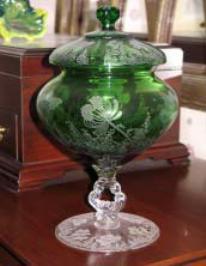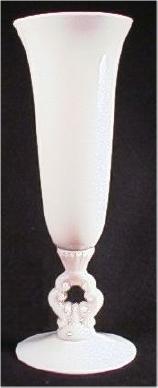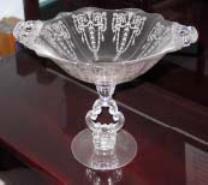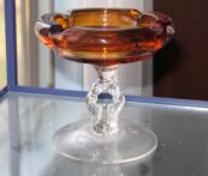The Keyhole
by Alex Citron
Issue No. 395 - April 2006
The Cambridge Keyhole is an instantly recognizable, unique and
versatile feature. It is found on dozens of pieces of Cambridge glass,
from vases to ashtrays to relish trays to comports. and it was - as far
as we can tell - not reproduced or closely copied by any other
glassmakers at the time. It is found in a number of sizes, from the
tiny knob atop a puffbox or perfume bottle, to a handle better than
five inches across on an early two-part tray. It was adapted to become
 the handles on the 3400 line, and stretched to become a stem on a tall
3400 comport.
the handles on the 3400 line, and stretched to become a stem on a tall
3400 comport.
Introduced in the 1920s, the Keyhole was still being used when the plant closed for good in 1958. It is, of course, most commonly found on vases. The Keyhole stem and foot are usually crystal, but the vases are known in nearly all the Cambridge translucent colors (plus Ebony and Crown Tuscan).
The earliest record of the Cambridge Keyhole is found in a patent application dated May 29, 1928. It is for a ten-sided (Decagon) Center-Handled Tray. These trays have been seen most often in Peachblo and Light Emerald, but also appear in Crystal, Willow Blue, Amber, Ebony and Blue II.
Another patent for a Keyhole piece was issued on April 30, 1929; this time for the three-light Keyhole Candle Holder. That piece was later adapted into a two-light, with a knob in place of the center candle cup. Even later, a single-light Keyhole Candlestick was introduced, on both Decagon and round bases. The two-light and threelight Keyhole Candles Holders also were made on both bases.
The 1929 Cambridge Catalog shows these Keyhole pieces (C-H means center- handled):
- #870 Decagon Center-Handled Tray
- #879 Decagon C-H Cupped Tray
- #861 Decagon 3-Part C-H Relish
- #638 Three-Light Candle Holder
- #880 Bridge Set Tray
- #893 12 in. Two-Part Tray
(This piece has the largest Keyhole made by Cambridge, over 5. in height)
Also in the 1929 Catalog are a number of Decagon platters and bowls with the adapted Keyhole-style handles. Keyhole pieces are shown with Etches 731, 713, 732 and Cleo.
By the 1930 Catalog, the Two-Light Candle Holder and the One-Light Keyhole Candlestick have been introduced and numbered as part of the 3400 Line. Also, a 3400 version of the Center- Handled Tray debuts. All three pieces were often etched Apple Blossom. A small, two-part Relish with a Keyhole Handle (#1093) shows up in 1930, as does the first use of a Keyhole knob, on a #864 Covered Candy Box. The 1930 Catalog also features the first examples of Keyhole pieces with cuttings, notably the #542 engraving on a C-H Tray.
 In the 1931 Catalog, Keyhole pieces are shown in all Ebony,
decorated with silver Gloria and Apple Blossom. But the big development
in 1931 was the introduction of the Keyhole Vase (at left), now the "Big Dog" of
the Keyhole line. Initially, there were five vases made:
In the 1931 Catalog, Keyhole pieces are shown in all Ebony,
decorated with silver Gloria and Apple Blossom. But the big development
in 1931 was the introduction of the Keyhole Vase (at left), now the "Big Dog" of
the Keyhole line. Initially, there were five vases made:
- #1233 9½ in. Pinched Vase
- #1234 12 in. Pinched Vase
- #1237 9 in. Flared Vase
- #1238 12 in. Flared Vase
- #1239 14 in. Flared Vase
All five vases came in many colors, and with a number of etchings, including Lorna, Gloria, Diane, Portia and Apple Blossom. All the Flared Vases were made in regular and optic; in fact, the 14 in. Flared Vase is usually found in optic unless etched. Along with these conventional vases, the #1305 Keyhole Globe Vase was introduced. These also were done plain and optic, and often featured etchings. In 1932, they were issued with a lid as #1304. At some point, the #1299 Vase was put on a Keyhole stem, but since it doesn't appear in any catalogs, we cannot be positive when that vase was in the line. But since the #1299 Keyhole Vase was also done with a lid in 1932 (numbered as #1318), we can probably safely assume the unlidded #1299 was available at the same time. One possibility, of course, is that the unlidded ones found today are simply missing the lid, and were never actually sold unlidded by Cambridge.
1931 also features the #1274 Tall Keyhole Candelabra, a two-light usually with bobeche and prisms. In addition, the Keyhole Comports and Fruit Bowl were launched. The #3400/28 Low Comport and the #3400/29 Tall Comport differed in that the Keyhole itself was stretched to achieve the extra height of the #29. The #3400/30 Fruit Bowl, almost always found with an etching, is today one of the most desirable pieces for Keyhole collectors.
In 1932, the Keyhole Tall Candelabra was adapted with cross-hatching and an "acorn" knob, and issued as a part of the Mt. Vernon Line (#38). With bobeche and crystals, it is one of the most imposing pieces of Cambridge glass, standing a full 14 in. tall. When Crown Tuscan came into the Cambridge Line, Keyhole pieces were made in the Candle Holders, Flared Vases and the Globe Vase. All these pieces were entirely Crown Tuscan, and were often decorated with a gold silkscreen like D1007-8. By the middle 1940s, Flared Keyhole Vases were being made in All-Ebony, All-Emerald and All-Mandarin Gold. All three colors were apparently made in the 9 in. and 12 in. versions, but are not known in the 14 in. or Pinched Vases.
 In the 1940 Catalog, we still find Keyhole Comports (only the short
one), Candle Holders (single, double and triple), C-H Trays, Bridge Set
Trays, Flared Vases (all 3 sizes) and pinched Vases (both sizes).
In the 1940 Catalog, we still find Keyhole Comports (only the short
one), Candle Holders (single, double and triple), C-H Trays, Bridge Set
Trays, Flared Vases (all 3 sizes) and pinched Vases (both sizes).
The most important new Keyhole piece in this catalog is the Keyhole Ivy Ball (#1236). It is known in many colors on crystal stem and foot: Amber, Amethyst, Carmen, Forest Green, Royal Blue, Peach-blo, Light Emerald and Mulberry (rare). It is also known in all Crystal, all Crown Tuscan and in Mandarin Gold with Amber stem and foot. Strangely, no examples of this piece in Moonlight are known to exist. A few ivys were cut or etched, but most are plain.
 The keyhole Ashtrays (3 in. and 6 in.) are not pictured in any of
the catalogs, but must have been an earlier piece, since they have been
seen in Heatherbloom as well as crystal and the "jeweltone" colors.
The keyhole Ashtrays (3 in. and 6 in.) are not pictured in any of
the catalogs, but must have been an earlier piece, since they have been
seen in Heatherbloom as well as crystal and the "jeweltone" colors.
By the time of the 1949 Catalog, we still find the Candle Holders in one and two-light, but the three-light seems to have been discontinued. A #1603, single-light Candle Holder with Bobeche and Hurricane had apparently been added. All three sizes of Flared Vases plus the Ivy Ball were still in the line. Everything else had been dropped by that time.
During the "reopen" period (1956-58), the Keyholes have nearly vanished. The #1603 Hurricane, the Single and Two-Light Candle Holders and the 9 in. and 12 in. Flared Vases are all that remain of this once extensive line.
Since Keyhole pieces were made in so many shapes and sizes, in so many colors; and feature numerous etchings, cuttings, silkscreens, Charleton decors and other embellishments, they have remained popular with Cambridge collectors. And the search continues for the elusive Moonlight Keyhole Ivy Ball.
